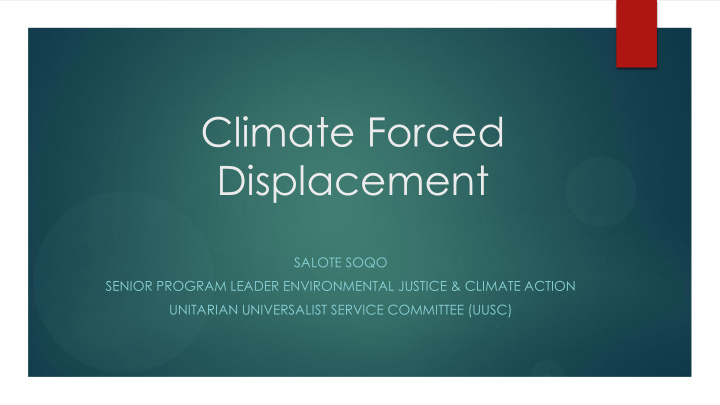



Climate Forced Displacement SALOTE SOQO SENIOR PROGRAM LEADER ENVIRONMENTAL JUSTICE & CLIMATE ACTION UNITARIAN UNIVERSALIST SERVICE COMMITTEE (UUSC)
UUSC’s Program: South Pacific EJ & CA Climate Forced Program Displacement Alaska Goal : To protect the rights of people that are forcibly displaced by climate induced environmental issues in the South Pacific and in Alaska. Partnership with the most affected : Through grantmaking, research and advocacy Vision: That a human-rights centered approach is adopted by local and international policy to address the needs of communities to build protections in place, to uphold their rights and to migrate with dignity.
Climate Forced Displacement 1 person/second is displaced by an environmental catastrophe/natural disaster Climate change is a multiplier of risks: food, water and livelihood insecurity, incites violence and conflict Climate displaced peoples don’t have any protection under international laws Widening existing problems - Existing environmental problems + economic injustices, gender and Involuntary or Forced class inequality, exploitation of natural disasters & climate Displacement change impacts indigenous peoples and resources = Forced displacement
South Pacific Islands
Climate Change Impacts in the South Pacific Food insecurity, Kiribati Sea level rise, Tuvalu Coral Bleaching: Fiji Cyclone Winston, Fiji 2016 Cyclone Pam, Vanuatu 2015 Water insecurity, Tuvalu
Fiji 332 islands in 75,000 sq. miles ~900,000 population Economy: Tourism, sugar export, minerals, agriculture SLR, increased sea surface temps, increased cyclone frequency and intensities Food and water insecurity is prevalent in rural areas and outer islands Many villagers are battling with encroaching erosion due to sea level rise and coastal storms ~830 communities at risk. Over 45 coastal communities need to be relocated by 2025
Vunidogoloa & Narikoso Vunidogoloa relocated to Narikoso relocating to Kenani neighboring tribal lands Relocation period: 2007 to 2014 Relocation period: 2011 - ? Cost ~$1million (Paid by the Cost ~$1.7million (Paid by the state & village) state & village) Relocated 126 villagers (26 Relocate 7 households (26 houses) houses) Benefits: Safety, easier access Benefits: Safety from coastal to transportation and inundation healthcare, improved Challenges: Physical infrastructure, hope for the separation from community … future. Challenges: Loss of cultural lands, ancestral ties, burial site.
Fiji’s National Response & Needs National Relocation Guideline International commitments to reduce GHG emissions Based on pilot studies from Vunidogoloa and Narikoso Funds & Technical Assistance for Adaptation Integrated Vulnerability Assessments (IVA) Coastal resilience Build climate resiliency through Flood control measures adaptation Drought alleviation measures Advocacy for GHG mitigation Resilient agricultural systems
Recommend
More recommend